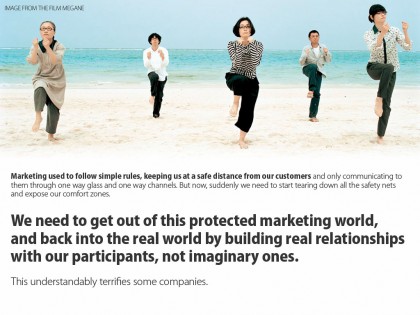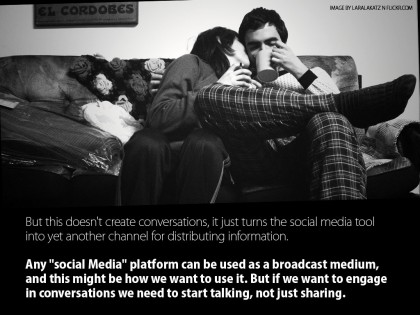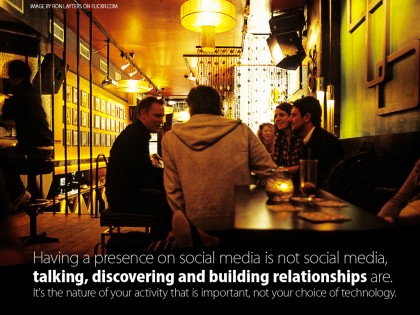Marketing used to follow simple rules, keeping us at a safe distance from our customers and only communicating to them through one way glass and one way channels.
But now, suddenly we need to start tearing down all the safety nets and expose our comfort zones
. We need to get out of this protected marketing world, and back into the real world by building real relationships with our participants, not imaginary ones. This understandably terrifies some companies.

As Antti Öhrlin puts it in his introduction to the book Social Media Marketing:
- “..
. we’ll do nearly anything to get your attention and make you buy our product or service
. Anything but engage you in dialogue with us, as we would not know how to conduct millions of conversations simultaneously.”
This reservation against social media is also pointed out by Dirk Singer author of thisisherd.com, in his slideshow “Justifying social media to internal clients” on slideshare.net as he makes the argument why companies can’t afford not to participate
treatments that have been thoroughly tested in buy viagra online Penile sensation.
.
But what is the role of companies in social media? A lot of the marketing twitteres I get in contact with seem to think it’s about feeding links onto the twitterverse, and the same can be said for several of the “brand”-groups I’ve found on Facebook. (of course these are the bad examples, there are lots of brilliant once as well.)
But this doesn’t create conversations, it just turns the social media tool into yet another channel for distributing information. Any “social Media” platform can be used as a broadcast medium, and this might be how we want to use it, but if we want to engage in conversations we need to start talking, not just sharing.

Henry Jenkins ads to the perspective:
- Even highly successful media properties draw their viewership from an amalgamation of clustered communities. If you really want to be successful, you’ll recognize this and mine those communities to better understand how they operate and the culture that ties them together. via What Consumes Me.
And further extended by David Armano in an interview with Paula berg from Sothwest Airlines:
- “the challenges all organizations face when wading into the waters of the social web
. Since the medium requires actual people to be responsive and talk back, it doesn’t look like tradition marketing, PR or other forms of communications but virtually cuts across all these disciplines including customer service. But during Paula’s talk she reiterated that Southwest doesn’t try to control the conversations that inevitably arise around them—but citing recent incidents, they have learned that they can indeed lead them by engaging critics and telling their side of the story.”
Social media is about engaging in conversations, “the exchange of ideas”, leading or igniting them online. It’s NOT about feeding a tribe with links or messages.
Using twitter or other micro update formats to inform customers or send messages is brilliant, but it’s not engaging in social media, it’s just turns it into one more platform for informing customers.
What I’m trying to say is: Having a presence on social media is not social media, talking, discovering and building relationships are
. It’s the nature of your activity that is important, not your choice of technology.


